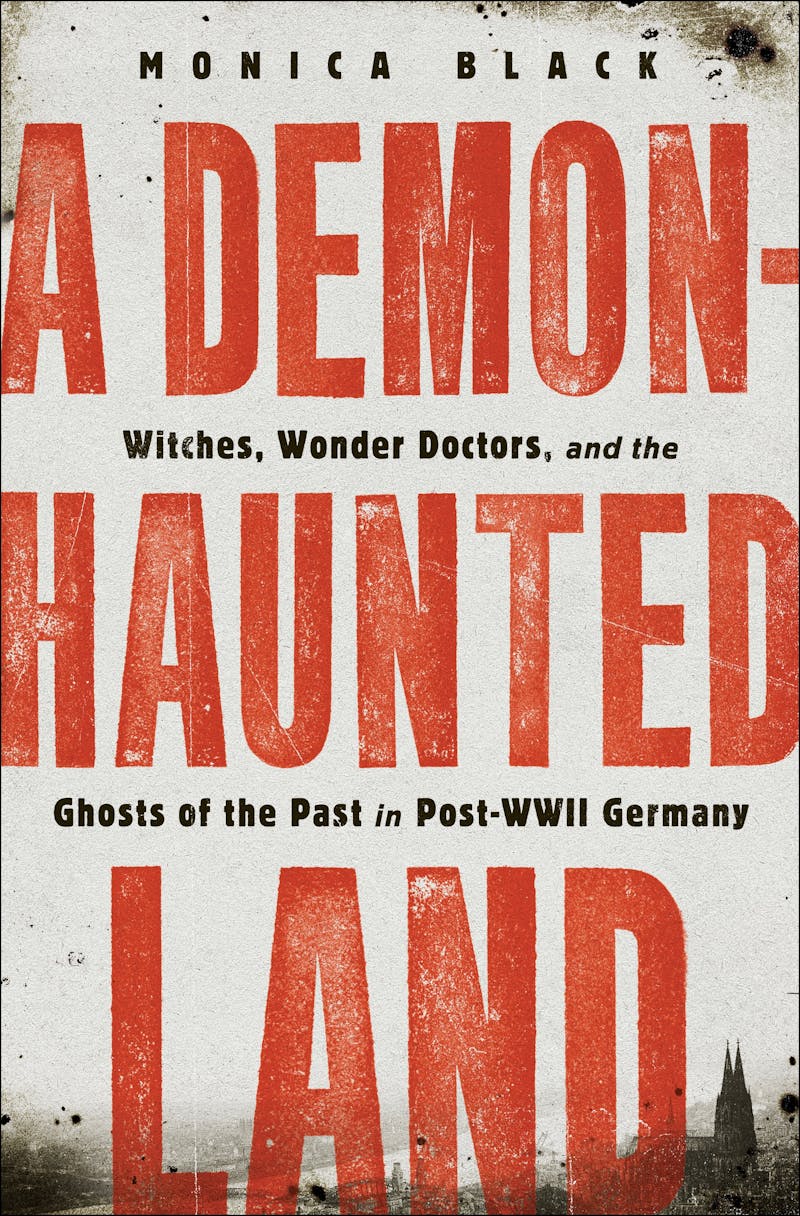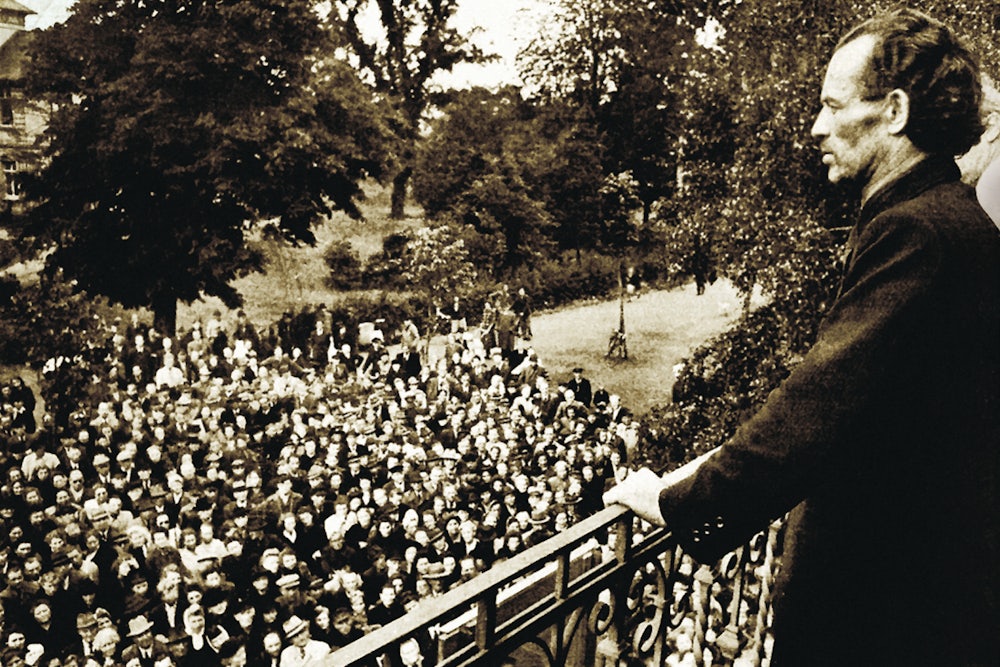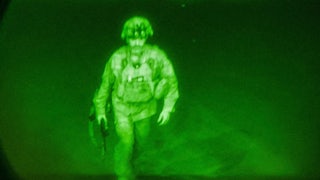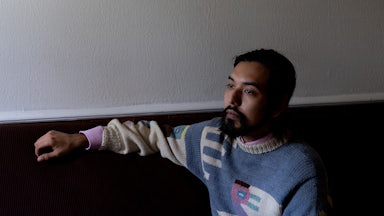“When World War II came to an end,” Monica Black notes, “Germany lay in ruins. Entire cities had been shattered by bombs and artillery, expanses of land left bare where every tree had been cut down for fuel, parts of the country practically erased.” For 12 years, Germans had lived under a regime that had shaped their lives in ways so intense that large numbers of them could not imagine a life without Hitler and the Nazi Party and killed themselves in one of the greatest waves of mass suicide in history. Even before the end of the war, reports from the Security Service of the SS had described popular feelings of “mourning, despondency, bitterness, and a rising fury,” expressing “the deepest disappointment for having misplaced one’s trust.” In the months that followed the war’s end, such feelings became ever more widespread. What had been the point of all the hard work and sacrifice? Inflation was out of control, and the basic necessities of existence had to be acquired from a black market mired in violence and criminality. The values inculcated by the Nazi regime had been upended. The present was unbearable, the future uncertain.

In her prizewinning book, Death in Berlin: From Weimar to Divided Germany (2010), Monica Black charted the impact of two world wars on Berliners’ attitudes toward death and mourning. In her new book, she looks at how Germans more generally sought to come to terms with their sudden disorientation through fantasies about “good and evil, innocence and guilt, sickness and healing.” These were displaced from the horrors of the Holocaust and the Nazi mass murders of the mentally ill and handicapped, of resisters and homosexuals, of Poles, prisoners of war, and millions more. Nobody was willing, or perhaps able, to discuss these and projected them onto smaller and more manageable psychic dramas of faith healing and witchcraft, the inexplicable and the supernatural. The moral, social, and epistemic void in which Germans found themselves after defeat was filled, at least for a time, by the irrational.
This situation, Black argues, persisted well after the process of reconstruction and rehabilitation in Germany had got underway, undermining the common portrayal of early postwar history as a story of gritty and determined Germans heroically working to rebuild their shattered land. “Fears of spiritual defilement, toxic mistrust, and a malaise that permeated daily life” were widespread; deep-rooted anxieties “churned away throughout the 1950s against the backdrop of consumerist forgetfulness.” In the university town of Göttingen, the folklorist Alfred Dieck was collecting the rumors and prophesies he encountered in the region. The blind faith people had placed in Hitler, now destroyed, was, he thought, finding an outlet in warnings of a coming apocalypse, amplified by the emerging sensationalist popular press.
So common were these by 1949 that they amounted, he concluded, to a kind of mass psychosis. The earth was about to shift on its axis; or the guilty would be swept away in a flood of biblical proportions. Many if not most people, Dieck observed, “felt largely blameless” for the horrors the Nazis had inflicted on the world, and there was still a widespread belief that “American financial circles” (code for Jews) had brought about both world wars and the defeat and humiliation of Germany in 1918 and again in 1945. But the apocalyptic rumors he collected, Black says, also surely expressed a sublimated consciousness that Germans were guilty of the horrendous crimes that none of them wanted openly to discuss.
In the same month, March 1949, and in the same area, Bruno Gröning, a faith healer, was reported to have effected a sensational cure in the small town of Herford, curing a young boy named Dieter Hülsmann of a lameness that had defied the efforts of more conventional medical practitioners to heal, and getting him to walk. The story quickly achieved wide circulation. Soon Gröning was being interviewed in the press, on radio, and in the newsreels. Gaunt and wiry, with a weathered face and—like Hitler—piercing blue eyes, he dressed modestly in dark clothing and spoke in simple though often vague aphorisms. He did not cure the sick by means of elaborate rituals or ceremonies, but mostly by just being close to them for sometimes hours on end, focusing his gaze on them, and then telling them they were healed. He didn’t write books, or found a church, or try to make a fortune out of his supposed gifts. Born in 1906 and brought up in a suburb of Danzig, Gröning was a Roman Catholic, served in the war, and was captured by the Red Army in March 1945, making his way to West Germany a few months later as a refugee. Married in 1928, he had two children, both of whom died young. During his time in Danzig, he had worked as a carpenter, an electrician, and a horologist.
In 1936, his family had Germanized its name from the Polish-sounding Grönkowski. He had joined the Nazi Party, but was never more than an ordinary member. He talked a great deal about his struggle against “evil people” and presented his healing powers as God-given. In many ways, his procedures were a modernized form of the casting out of evil spirits, or exorcism of the devil. But it was unclear what exactly he meant by “evil.” The vagueness of his rhetoric precluded any direct reference to Nazism. “I cure the incurable,” Gröning declared. How can we explain his apparent healing powers? Certainly in some cases they worked either only briefly, or not at all. Dieter Hülsmann, the young patient whose cure began Gröning’s career, was soon bedridden again, unable to walk. A young diabetic came off insulin after he heard Gröning say that anyone “who had the proper belief in God was healed.” Before long, the young man had slid into a coma. His life was only saved when he went back on his medication.
But leaving these obvious failures aside, it was clear that Gröning did have the power to cure at least some people. Medical experts who investigated his claims reached the conclusion that a good number of the ailments from which his patients suffered were psychosomatic. Traumatized, despairing, many seem to have been experiencing symptoms of hysterical paralysis. Official medicine under the Third Reich had been impersonal, ostentatiously “scientific,” and authoritarian. Up to 400,000 people supposedly suffering from allegedly hereditary ailments (including alcoholism and “asocial” behavior) had been forcibly sterilized; 200,000 “inferior” patients, many of them children, had been murdered in mental hospitals in the name of improving the quality of the German race. Gröning, by contrast, listened to his patients. As he sat by them, they told him their deepest worries and their most desperate experiences. His emphasis on faith in God as a cure appealed to the religious sensibilities of what, above all in the countryside and small towns of provincial Germany, was still a deeply Christian society.
A physician who carried out a study of some 80,000 letters Gröning received—over half of them from women—found that a high proportion of them discussed not so much the physical ailments of the writers as the terrible experiences they had been through, “nights under falling bombs, … flight and hunger, fallen fathers, fallen sons, assaults and rape.” They reflected the “mass fate” of the Germans, “the history of German suffering,” a widespread self-perception of Germans as above all victims of the war. Under Nazism, Germans had been forced to repress their consciousness of suffering in order to conform to an ideology that stressed stoical acceptance of death, loss, and sacrifice. Now they could let it all out.
With its appeal to deep-seated collective emotions, Gröning’s movement soon mushroomed into a major phenomenon. People began to write to him from all over Germany, seeking a cure for their ailments. Reports of miraculous healings began to multiply. There were articles in the press. Der Spiegel featured him on its front cover. When Gröning and his entourage descended on Munich, huge crowds gathered. The merest rumor that he was about to appear somewhere caused thousands of people to rush to the spot, holding up traffic. Some lay down in front of his car as he arrived, saying (according to a police report) “he should heal them or run them over.” When he moved for a time to a farm outside the Bavarian town of Rosenheim, the crowds that gathered were so large that the Red Cross felt obliged to provide tents for them to shelter in.
The psychiatrist Alexander Mitscherlich, founder of a clinic for psychosomatic medicine at Heidelberg University in 1949, considered Gröning and his followers dangerously close to providing a kind of substitute for Hitler and the Nazis. He diagnosed in the faith healer a “pathological sense of mission,” offering a kind of psychological refuge from a world in which—as he argued in his later book The Inability to Mourn, co-written with his wife, Margarete Nielsen Mitscherlich—Germans were unable to process their previous complete identification with the Nazi leader and so deeply needed some way of dealing with this. Gröning’s exorcising of the “evil” within his patients perhaps allowed them to admit to themselves that they had unquestioningly gone along with, even enthusiastically supported, what they were now being told (and shown in atrocity films that Allied occupation forces made them watch) was the most evil regime in history. The danger Gröning posed, however, was debatable. He does not seem to have harbored any political ambitions, nor could he really be regarded as a threat to the fledgling West German democracy. Nevertheless, observers found the unbridled enthusiasm of his followers and the near-hysterical atmosphere at his meetings unnerving. One physician who attended a meeting thought the “ridiculous” pose he struck on stage reminded him “uncomfortably of Hitler.”
And indeed, some of the people who came to work for Gröning were unreconstructed followers of Hitler. The most prominent of these was Otto Meckelburg, who originally approached Gröning in search of a cure for his wife’s hyperthyroidism. Observing the enthusiasm the healer generated among his followers, Meckelburg began to help him in various ways, set up his numerous tours and visits, and ended by running his mission as a business. He persuaded Gröning to sign a contract that gave him power of attorney over Gröning’s finances, created a formal organization to run his affairs, and began to charge people for access to his healing powers. Some critics alleged that Meckelburg and his wife also procured young women from among his followers for him to have sex with. Renée Meckelburg put him on a regular diet (or at least, she tried to); tidied up his unruly, rather lengthy hair; and provided him with a change of clothes (up to this point, he had only owned one set of clothes, which, Black reports, “he carefully washed and placed on the heater each night to dry.”)
Otto Meckelburg, however, had a Nazi past of far more serious dimensions than Gröning’s. Born in 1911, he had joined the SS shortly after the Nazi seizure of power, and worked for a time in the Death’s Head regiment, which staffed the concentration camps. In 1942, he was appointed company commander in the Prinz Eugen Division of the Waffen-SS, whose anti-partisan operations in Yugoslavia involved numerous atrocities committed against the civilian population. After the war, he assumed a false name and went underground, subsisting from black market operations of one kind and another. His association with Gröning, along with a general amnesty offered by the Adenauer government in September 1949, allowed him to resume his real identity and make a decent living, his past generally unsuspected by all around him. The Meckelburgs sought to impose a kind of bourgeois respectability on Gröning’s operation, regarding his existing entourage as “parasites,” and bullying and threatening people if they didn’t pay up for their treatment. They kept a close eye on the faith healer, always accompanying him when he went out. These tactics certainly worked, at least for a time. On one evening during Gröning’s tour of Frisia, they raked in some 34,000 German marks in donations. Otto Meckelburg bought himself a new Opel with the proceeds, and then a Mercedes. The couple made plans to open a permanent cure center where Gröning could practice his craft.
Gröning and the Meckelburgs soon got into trouble with the authorities, however. The startling dimensions reached by their movement attracted the attention of the police. In 1939, the Third Reich had issued a decree banning lay healers from practicing without a license, and the measure had not been revoked along with other Nazi laws. Bavarian politicians now debated whether the law should be applied to Gröning, or whether it should be disregarded as a “Nazi law.” Moreover, a cure center required a license, and the authorities were unwilling to grant it in view of Meckelburg’s reputation as a grifter, dating to his days as a black marketer, and multiple allegations of his extortionate behavior toward potential patients. He was a “con man,” one official said. Gröning could only expect official support if he broke with his manager. As a formal investigation was launched, Meckelburg was deprived of his power of attorney, and the two men parted company.
Gröning spent an increasing amount of time in the courts, charged with a variety of offenses, from fraud to negligent homicide by depriving a patient of medical treatment with promises of curing the tuberculosis from which she eventually died. In 1958, he was sentenced to eight months in jail. The crowds had fallen away, though he still had his supporters. By February 1959, he was dead, a victim of stomach cancer, though some speculated that he had died because he had asked his patients once too often to “give him their illnesses.” Meckelburg went on to manage another faith healer, Pietro Tranti; his past caught up with him, however, and he was indicted by the Yugoslav War Crimes Commission and the United Nations for his role in the SS Prinz Eugen Division during the war.
Bruno Gröning was not the only cult figure to attract a following in early postwar Germany. The cabinetmaker Waldemar Eberling, in rural Schleswig-Holstein, claimed to have effected a number of cures in the 1950s in a similar manner, identifying as the cause of his patients’ afflictions an evil force that he then proceeded to banish from the scene. In some cases, he associated this with particular individuals, whom he identified, in effect, as witches. His ideas and practices were certainly idiosyncratic. Interviewed by journalists, he claimed that people had two brains and three nervous systems, and when one of them went wrong, another had to be activated as a substitute. Apart from prescribing folk remedies such as gentian root or asafetida powder, and getting people to pin bits of paper with biblical quotations onto their clothing, he also diagnosed ailments by having patients look through their bed feathers in search of significant patterns.
One of them found three heart shapes, two of which were “sticky with blood.” Eberling told her to burn them, which she did, and asked her if she had any enemies in her village. Yes, she replied, her family had been in charge during the Nazi period—her father-in-law was village mayor—and, following the “downfall,” their enemies had treated the family very badly in the process of denazification and land redistribution. Eberling had identified one of them, the first postwar mayor, as an “evil force” when the man cycled past as he was interviewing the family. The man got wind of this and complained to the police. The village, the police commented wearily, had always been prone to “witch mania.” But since Eberling had accepted money for his services, he was, they concluded, clearly in breach of the law banning lay healers.
Waldemar Eberling had in fact been practicing his arts since he had learned about them from a book lent him by his landlady in Dortmund in the late 1920s. In 1936, he had been sentenced to a term in prison for fraud. And indeed he was far from averse to using fraudulent methods to effect his cures. Called in to a family where the father had been forcibly sterilized in 1939 for being “slow-witted,” he sat with the man for some time, and then claimed he would soon be fertile again. After a few weeks, the wife duly fell pregnant. But later on she reported that Eberling had been walking with her one evening when he had taken hold of her and “had sexual intercourse” with her “standing up against the wall of the savings and loan.” She had not felt threatened, she said, and the sex had been consensual. But it put his methods in a dubious light, to say the least.
Eberling was eventually convicted of contravening the law against lay medical practitioners and sentenced to four months in prison, though his conviction for fraud was quashed on appeal. This did not stop people from seeking him out to help them in their distress; some even came from across the nearby Danish border. Johann Kruse, a retired schoolteacher in the area where Eberling practiced, unfolded a vigorous campaign against him, arguing that the kind of witch-hunting he carried out bore uncomfortable resemblances to the Nazi scapegoating of the Jews.
An opponent of militarism, a rationalist, Social Democrat, and bitter critic of the Nazis, Kruse generated a lot of publicity for his views. He fought successfully to get the authorities to take a stand against popular magic books such as The Sixth and Seventh Books of Moses, which promoted quack remedies for diseases like syphilis. Particularly disturbing, at least for postwar sensibilities, was the tendency of the book to associate black magic with Jews. Kruse testified to its harmful nature in a widely publicized court case that resulted in the book’s publishers being fined for fraud and the book taken off the shelves, though the verdict was overturned on appeal.
A Demon-Haunted Land is absorbing, gripping, and utterly fascinating. It kept me enthralled right up to the end. Black certainly knows how to tell a good story. Beautifully written, without even a hint of jargon or pretension, it casts a significant and unexpected new light on the early phase of the Federal Republic of Germany’s history. Black’s analysis of the copious, largely unknown archival sources on which the book is based is unfailingly subtle and intelligent. Nevertheless, in the end, I found myself less than fully convinced by its arguments. In the first place, the very large conclusions she reaches are drawn from two—just two—cases, one of which was confined to parts of western and southern Germany, the other to a single village in the north.
The Gröning case alone takes up well over half the book. If you want to argue that Germans, as a whole, responded to the calamity of defeat and the collapse of their mental and moral world in 1945 by turning to the irrational, you surely need more than this. Certainly, Black does cite a jump in witchcraft cases in the early postwar years. But these were still very few in number, and, without knowing more about them and how the statistics were generated, it’s impossible to reach any firm conclusions about their significance. If she had really wanted to generalize about German society as a whole, then she should have considered the big cities in which so many Germans lived, such as Berlin, which merits only four mentions in the index.
Secondly, if the overall argument was to be sustained, the book surely needed a stronger comparative dimension. It would have been worth, for example, looking back at similar outbursts of the irrational in modern German history instead of sticking almost entirely to the years after 1945. She devotes a few paragraphs to the girls who claimed to have seen the Virgin Mary appear to them in the Franconian village of Heroldsbach in October 1949, and the vast crowds that gathered to be healed there as the visions continued over the next few years, but her analysis would surely have benefited from a reading of David Blackbourn’s classic Marpingen: Apparitions of the Virgin Mary in Bismarckian Germany (1993), which provides a detailed and suggestive account of another, similar series of events three-quarters of a century earlier.
More important, spiritual healers have appeared, and continue to appear, with some frequency in other places and in other times. Black herself, still confining her attention to the postwar years, mentions “in West Germany, Trampler and Pietro Tranti; in France, Yves Albre and Lucien Rivet; in Great Britain, Harry Edwards; in the Netherlands, Greet Hofmans.” One could add many more, such as Oral Roberts in the United States. Nor was Gröning the “extraordinary novelty” Black claims he was in 1949; faith healers were active at other times and other places in German history, the subject of two major books, published some time ago by the German historian Ulrich Linse, on “barefoot prophets” and “visionaries and miracle-workers.” How extraordinary her two main subjects were remains open to some doubt, therefore. And Black is tilting at windmills when she claims that her book overturns an orthodoxy that sees postwar Germany entirely in terms of rational reconstruction and hard work: The chaos, despair, and disorientation of German society in the early postwar years have been documented by many historians, and nobody would assert that the “economic miracle” that established West Germany as a stable and prosperous country took hold before the middle of the 1950s, when Black’s stories effectively end.
Finally, Black dismisses as unthinking and unhelpful the characterization of Gröning, Eberling, and their followers by many contemporary commentators as relics of a backward and superstitious rural past. She brings out well their subtle and half-concealed relationship to the all-too-recent Nazi past. But Eberling’s activities did in fact take place in a deeply rural, traditional community, where social and interpersonal antagonisms that divided people had frequently taken the form, as the police noted, of “witch mania.” As she rightly comments, improved education, the arrival of television, growing mobility, and a host of other developments in the 1960s eventually made such attitudes and beliefs largely a thing of the past.
And yet, in the end, they have survived, even in a secularized form. If witchcraft accusations imputed ill will and the secret machinations of evil forces to events that were in reality perfectly capable of rational explanation, then so too do the conspiracy theories that are now running riot across the internet and social media and playing havoc with politics, not least in the United States. This is a history book, Black insists, but it also has a disturbing significance for our time.






